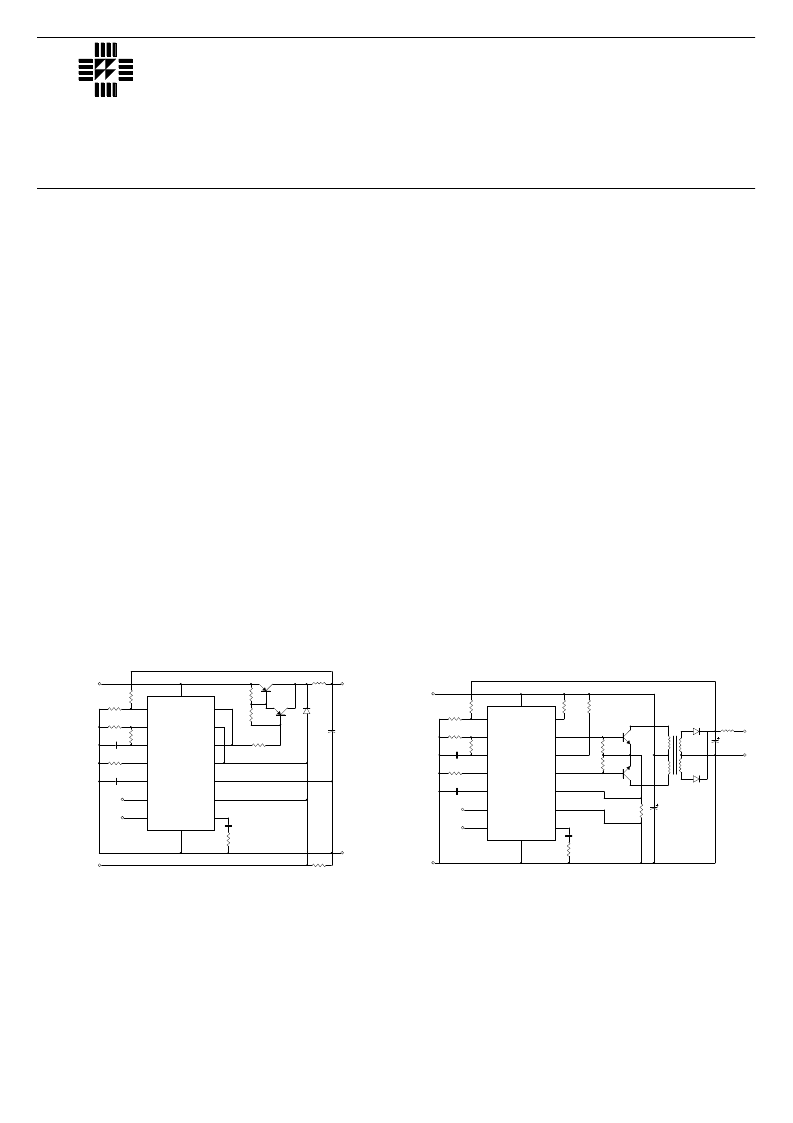- 您現(xiàn)在的位置:買賣IC網(wǎng) > PDF目錄360889 > IP1526AJ Analog IC PDF資料下載
參數(shù)資料
| 型號(hào): | IP1526AJ |
| 英文描述: | Analog IC |
| 中文描述: | 模擬IC |
| 文件頁數(shù): | 5/6頁 |
| 文件大?。?/td> | 72K |
| 代理商: | IP1526AJ |

LAB
SEME
IP1524 SERIES
Semelab plc.
Telephone (01455) 556565. Telex: 341927. Fax (01455) 552612.
Prelim. 3/95
APPLICATIONS INFORMATION
The IP1524 is a fixed-frequency pulse-width
modulation voltage regulator control circuit. The
regulator operates at a frequency that is programmed
by one timing resistor (R
T
) and one timing capacitor
(C
T
). R
T
establishes a constant charging current for C
T
,
which is fed to the comparator providing linear control of
the output pulse width by the error amplifier.
The IP1524 contains an on-board 5V regulator that
serves as a reference as well as powering the IP1524’s
internal control circuitry and is also useful in supplying
external support functions. This reference voltage is
lowered externally by a resistor divider to provide a
reference within the common-mode range of the error
amplifier or an external reference may be used. The
power supply output is sensed by a second resistor
divider network to generate a feedback signal to the
error amplifier. The amplifier output voltage is then
compared to the linear voltage ramp at C
T
. The
resulting modulated pulse out of the high-gain
comparator is then steered to the appropriate output
pass transistor (Q
1
or Q
2
) by the pulse-steering flip-flop,
which is synchronously toggled by the oscillator output.
The oscillator output pulse also serves as a blanking
pulse to assure both outputs are never on
simultaneously during the transition times.
The width of the blanking pulse is controlled by the
value of C
T
.
The outputs may be applied in a push-pull
configuration in which their frequency is half that of the
base oscillator, or paralleled for single-ended
applications in which the frequency is equal to that of
the oscillator. The output of the error amplifier shares a
common input to the comparator with the current
limiting and shutdown circuitry and can be overridden
by signals from either of these inputs.
This common point is also available externally and
may be employed to control the gain of, or to
compensate, the error amplifier, or to provide additional
control to the regulator.
REF
V
R
T
C
T
INV.
N.I.
OSC.
SH.DOWN
COMP.
C
A
E
A
E
B
C
B
C +
L
C -
L
I N
V
GND
+28V
RETURN
G ND
+5V
1A
0.1
μ
F
0.02
μ
F
0.1
500
μ
F
1N3880
5k
5k
5k
5k
3k
0.001
μ
F
68
150
2k
50k
0.9mH
REF
V
R
T
C
T
INV.
N.I.
OSC.
SH.DOWN
COMP.
C
A
E
A
E
B
C
B
C +
L
C -
L
IN
V
GND
+28V
RETURN
0.1
μ
F
0.01
μ
F
5k
5k
5k
5k
0.001
μ
F
1mH
2k
20k
1k
1 W
1k
1 W
1k
1k
20
T
20
T
100
μ
F
0.1
5
T
5
T
5 V
5 A
100
μ
F
In this conventional single-ended regulator circuit, the two outputs of
the IP1524 are connected in parallel for effective 0-90% duty cycle
modulation. The use of an output inductor requires an R-C phase
compensation network for loop stability.
Push-pull outputs are used in this transformer-coupled DC-DC
regulating converter. Note that the oscillator must be set at twice the
desired output frequency as the IP1524’s internal flip-flop divides the
frequency by 2 as it switches the PWM signal from one output to the
other. Current limiting is done in the primary so that the pulse width will
be reduced should transformer saturation occur.
相關(guān)PDF資料 |
PDF描述 |
|---|---|
| IP1526AN | Analog IC |
| IP1526D | Analog IC |
| IP1526J | Voltage-Mode SMPS Controller |
| IP1526N | Analog IC |
| IP3526D-18 | Analog IC |
相關(guān)代理商/技術(shù)參數(shù) |
參數(shù)描述 |
|---|---|
| IP1526AJ/883B | 制造商:未知廠家 制造商全稱:未知廠家 功能描述:Voltage-Mode SMPS Controller |
| IP1526AJ-883B | 制造商:SEME-LAB 制造商全稱:Seme LAB 功能描述:Advanced Regulating Pulse Width Modulator |
| IP1526AJ-BSS2 | 制造商:SEME-LAB 制造商全稱:Seme LAB 功能描述:Advanced Regulating Pulse Width Modulator |
| IP1526AJ-DESC | 制造商:SEME-LAB 制造商全稱:Seme LAB 功能描述:Advanced Regulating Pulse Width Modulator |
| IP1526AN | 制造商:未知廠家 制造商全稱:未知廠家 功能描述:Analog IC |
發(fā)布緊急采購,3分鐘左右您將得到回復(fù)。